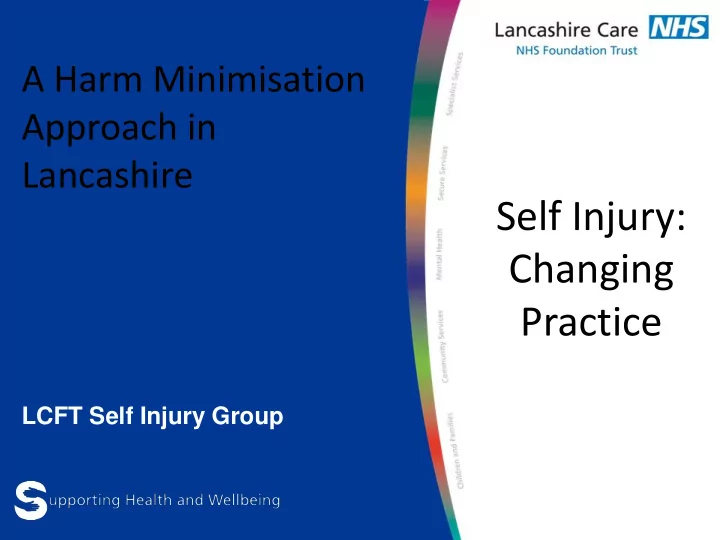

A Harm Minimisation Approach in Lancashire Self Injury: Changing Practice LCFT Self Injury Group
Self Injury & Research Interest Group Clinical Network Representatives Experts By Experience HEI’s Third Sector Organisations Service Users / Carers Academics / Training Consultants Other NHS services (A&E)
Objective of the Group • To support and promote the adoption of an evidence based approach to self injury & harm minimisation across all LCFT services and inpatient settings, so that every Service User / Patient can expect a consistent and helpful response from a supportive and confident member of staff.
What we have done so far? • Self injury Conference in 2011 • Level one basic online learning package (1822 Hits) • Level two intermediate face to face training (180 Staff) • Knowledge file (Ref in: Safe and Secure DoH 2012) • Self Help for Self Injury Resource Booklet (Safe and Secure DoH 2012) • Positional statement
That’s where the CLAHRC Evidence for change programme has helped Dedicated time + Dedicated people + Dedicated support and experience + Rigour and validation to the process and the results. _______________ FOCUS ON ACTION
Drivers for Change • Improved quality of care and experience • Reducing restrictive practice • Harm free care • Violence Reduction CQUIN • CQC Action Plans • Staff Wellbeing • Challenging health inequalities
Where do we start? • 1. To accept alternatives to a purely preventative or curative approach towards self injury. • 2. To recognise and support the use of safer self injury / harm minimisation approaches by staff, where such approaches have been assessed and identified as the most clinically, ethically and risk management appropriate intervention with clients. • 3. To accept that for some individuals, self injury may represent a long-term coping strategy that they may not wish to change, or be able to change in the short, medium or longer term.
Benefits of harm Costs of enforced harm minimisation cessation • Taking more responsibility • Better relationships with • Coping strategy taken away staff • Possessions/possible tools to • Not being restrained harm with removed • Feeling more empowered • Increase in distress, anger, • More opportunity to explore frustration, guilt, shame etc alternative coping • Use extreme lengths/methods strategies of self injury • Feeling understood & • Taking any and every listened to opportunity to injure • “Knowing where I stand” • Consistency • Battles with service users, • Good relationships with power and control service user • “Them & us” poor • Feeling useful/job satisfaction relationships • Increase in morale • Increased restraint episodes • Confidence in intervening • Risk of injury/assault • Increase in skills • Lack of certainty/confidence • Less restraint • Poor morale/negativity • Less violence/injury • Less stress • Increased risk incident rates • Reduced violent incidents • Staff sickness and turnover • Reduction in restraints • Increased length of stay • Increased performance • Poor patient experience • Patient satisfaction • Financial impact (observations • Reduced risk and resources) • Staff morale, attendance and • Pressure on services retention increased • Decreased sickness
Methodology and Work Focus We came together regularly both virtually and in person to focus on a scoping review to inform: • Development of Policy / Best Practice Guidance • Implementation Strategy / Business Case
Results • We started to distil the knowledge and evidence from the literature to create a policy to support a harm minimisation approach to Self Injury. • We have produced a detailed review protocol. • Provided evidence that the proposed change in practice will provide a better experience for patients / Service Users. • We identified further areas for research.
Challenges • It’s a big task that needs strategic oversight with dedicated support, commitment and leadership. • We acknowledge that this remains a controversial and easily muddled subject area and that developments will involve inevitable ongoing tensions and debates regarding duty of care, capacity and consent issues. • There are some areas where a risk averse culture is evident. We need to challenge this by having clear published policy, guidance and implementation plan.
What Next? Policy Implementation Identify a cohort to follow in the implementation and measure the impact • Advanced Learning and development for specific practitioners around harm minimisation and formulation. • Plan care using five P formulation to create advance statements • Self injury specialists / advisors in teams support groups for family and friends
Recommend
More recommend